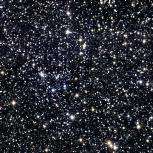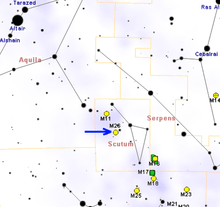Messier 26
| Messier 26 | |
|---|---|
 | |
| Observation data (J2000.0 epoch) | |
| Constellation | Scutum |
| Right ascension | 18h 45.2m |
| Declination | −09° 24′ |
| Distance | 5.0 kly (1534 pc) |
| Apparent magnitude (V) | 8.0 |
| Apparent dimensions (V) | 15.0′ |
| Physical characteristics | |
| Radius | 22 ly |
| Estimated age | 89 million years |
| Other designations | NGC 6694 |
Open Cluster M26 (also known as Messier Object 26 or NGC 6694) is an open cluster in the constellation Scutum. It was discovered by Charles Messier in 1764.
M26 spans about 22 light years across and is at a distance of 5,000 light years from the Earth. The brightest star is of magnitude 11.9 and the age of this cluster has been calculated to be 89 million years. An interesting feature of M26 is a region of low star density near the nucleus, one hypothesis was that it was caused by an obscuring cloud of interstellar matter between us and the cluster, but a paper by James Cuffey suggested that this is not possible, and that it really is a "shell of low stellar space density".[1] Recently, Michael Merrifield of the University of Nottingham said that there is, as yet, no clear explanation for the phenomenon. [2]

External links
- Messier 26, SEDS Messier pages
- Messier 26 on WikiSky: DSS2, SDSS, GALEX, IRAS, Hydrogen α, X-Ray, Astrophoto, Sky Map, Articles and images
Coordinates: ![]() 18h 45.2m 00s, −09° 24′ 00″
18h 45.2m 00s, −09° 24′ 00″
References
- ↑ Cuffey, James (1940). "The Galactic Clusters NGC 6649 and NGC 6694". Astrophysical Journal. 92: 303. Bibcode:1940ApJ....92..303C. doi:10.1086/144220.
- ↑ Merrifield, Michael (Oct 2, 2015). "M26 - Open Cluster". Deep Sky Videos. University of Nottingham/University of Sheffield. Retrieved March 29, 2016.
